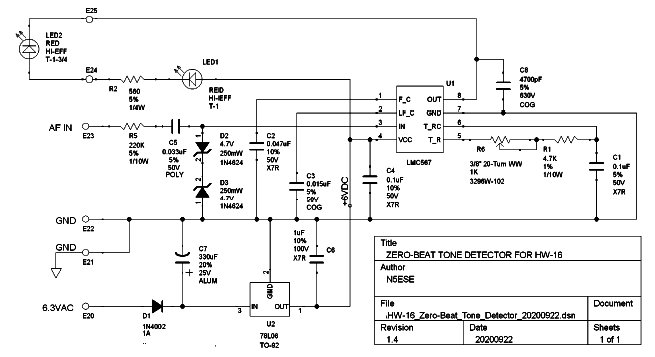
(click on any picture to see larger version)
As I age, I seem to have less and less confidence about "zero-beating" my VFO to a received signal. I think I might be going tone-deaf. You know the procedure - first find your received station, then adjust your VFO (in "SPOT" mode) to match that pitch. My brain and my ears used to be able to do that, but now...
So a visual aid "Zero-Beat Detector" can really help. Watching a red LED as indicator, one first adjusts the received signal so that the LED lights with the morse characters. That puts you at your desired position in the receiver passband. Then, you adjust your VFO (again, in "SPOT" mode) to light the light continuously. That should put you within 20 HZ or so of "dead on".
What I present here is a Zero-Beat Detector Mod (actually, an "Add") for the HW-16. Here's a schematic:

(click on any picture to see larger version)
Looking at the schematic, a sample of the receiver audio (AF IN)is AC-coupled and limited (by D2 & D5) and sent to U1 (LMC 567 PLL Phase Detector). U1 is configured to provide a flag (thumbs-up signal) when its internal VCO signal (roughly 750 Hz, determined by R1/R6 & C1) and the input audio are "exactly" equal. When that happens, U1's OUT sinks current, and the onboard and outboard LED's illuminate. This is our "Zero-Beat" detection.
+5VDC Power for U1 is generated by rectifier filter (D1 & C7) from 6.3VAC (filament supply) and U2 (78L05 3-terminal regulator).
If we mount the outboard LED right behind the transparent disc of the HW-16's main tuning dial, we'll see a red glow appear at top-center of the dial when we are zero-beat with the current received signal.
As we are often want to do, the Zero-Beat circuitry is mounted on perf board. Here's a picture:
(click on any picture to see larger version)
Here are some pix of the installation:
(click on any picture to see larger version)
In the above picture (looking down into the HW-16 from above), we can see the front panel on the left. The green perf board is our as-built Zero-Beat detector. Just inboard of the silver disk (main tuning dial), near it's mid-top, you'll see the red LED mounted such that it will shine into the back-side of the dial. Running along the edge (lower edge in this image) is a small coax, which is routed to the grid resistor near V6, to pick off the audio sample.
Here are two more details of the installation:
(click on any picture to see larger version)
In the image on the left, we are looking at the back of the front panel. Not an L-Bracket that mounts the perf-board Zero-Beat Detector in place, and note the way we used two L-brackets together to mount the red LED in just the right position to shine on the back of the main tuning dial. Not pretty, but very functional. And on the right image, Note the coax we talked about, and the wire connected to one side of the designated grid resistor.
For further part numbers and details on installation, refer to my HW-16 Mods Notes, and scroll down to the section "Actions 20200922" re Zero-Beat Detector.
With the red LED mounted "just so" it will be illuminating the portion of the dial which is where we're likely to be looking anyway, as we tune around the band. Once we identify a signal of interest, we just tune up and down slowly to find that "sweet spot" when the red suddenly appears on the dial. I find that I can usually tell if the tone is way high or way low in pitch, so I can usually get it "close" by ear, and then "dead nuts" by the red zero-beat indicator.
Of course, things can go wrong. If the band is especially noisy or full of loud signals (like during a big contest), the detector may indicate flashy-flashy all the time. And if the signal is especially weak, it may not indicate at all. However, you'll quickly learn what volume level the detector prefers, and you can increase the RF Gain as needed to make it work.
And when all else fails (which really isn't that often) we'll revert back to the old fashioned audio pitch "best guess" method HIHI.
73,
Monty N5ESE
dit dididit dit